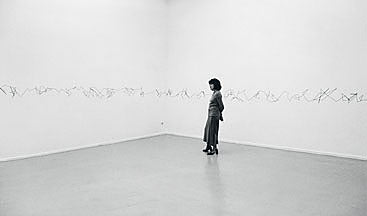
Born in 1924 in Budapest (HU)
Lives and works in Paris (FR)

1998-1999
Algorithm, black thread, nails
Dimensions variables
Year of Purchase: 2001
Vera Molnar represents one of the most radical trends of ‘minimalisme à la française’1 for which she helped to lay down the ground rules. Her early works, using an elementary formal vocabulary of lines, strokes etc. and two-colour (black and white) printing, developed quickly under the influence of Vantongerloo. The texts of this neo-plastician, who sought to define the pictorial surface and the composition of the picture using mathematical formulae, struck a chord with Vera Molnar’s own concerns and directed her work towards strict and systematic plastic research somewhat akin to the scientific method and the field of experimentation. Close to the Groupe de Recherche d’Art Visuel,2 in particular François Morellet, who advocated a rationalization of painting and proposed to lay the foundations for a science of art, Vera Molnar then overlooked the spiritual and symbolic dimension inherent in Vantongerloo’s work in order to focus entirely on the relationship between mathematics and art. The work is no longer anything but a visual experiment: ‘In my work, there are no ingredients of a mystical metaphysical symbolic nature, there is no message, no message and no racoon.’3
This approach based on the visual experience is done in conjunc¬tion with the research of her husband, François Molnar, who specializes in the psychophysiology of vision.
After 1968, Vera Molnar integrated the new technologies into her work. The computer became a tool she used for her experiments and the basis of a new creative method. The computer works are done by writing a program and hence a set of operations. The images then are produced according to a predetermined, rigorous system or method highlighting the production process. However the artist does not delegate the entire creative process: ‘the computer is no more than a tool that helps painting to shake off the deadweight of an ossified classical heritage. Its immense combinatorial capacity facilitates the systematic investigation of an infinite range of possibilities.’4
Promenade (presque) aléatoire is one of the artist’s more recent works. The work comes from an algorithm written by Vera Molnar, with programming by the artist and mathematician Erwin Steller. The forms generated by this mathematical figure are printed out and then reproduced on the wall of the exhibition space using small nails and black cotton thread. The hard copy is thus discarded in favour of the installation. She uses the lines, repeated in a continuous frieze with no beginning or end, to play on our perception of space and the surface of the wall. The rigorous, abstract mathematical formulae are embodied in the frail, sensitive material quality of a line that ‘moves along, jumping, sliding, groping, hopping, pushing, fleeing […], starting again and continuing dementedly on and on.’5
Hélène Guenin
1 An expression first coined by Serge Lemoine.
2 The ‘Groupe de Recherche d’Art Visuel’ was founded in July 1961 by François Morellet, Horacio Garcia Rossi, Julio Le Parc, Francisco Sobrino, Joël Stein and Jean-Pierre Yvaral.
3 Vera Molnar, Inventaire 1946 – 1999. Preysing-Verlag, Ladenburg, 1999, p. 47.
4 Jean-Michel Place, ‘Vera Molnar, Regard sur mes images’, in Revue d’esthétique, n° 7, Paris, 1984.
5 Vera Molnar, Solo d’un trait noir, 6 November 1997.